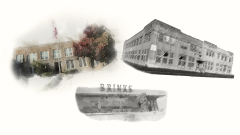
Demolition and dramatic new construction are reshaping our neighborhood at an increasingly fast rate. In the past, neighbors have organized to fight for the preservation of historic buildings, as they did with the Lakewood Theater, which is now a protected landmark. Thankfully, there are developers who see the value of working with preservationists to repurpose historic structures. Buildings like the Davy Crockett School, which was transformed into a modern apartment complex, are still standing as a result. But “progress” inevitably marches on, and many historic sites face uncertain futures. Each year, Preservation Dallas highlights places that are at risk of being lost forever. “Dallas has always been a city of newer, bigger, better,” says David Preziosi, executive director of Preservation Dallas. “It’s hard to fight that mentality. We do that by trying to raise awareness about why these buildings are important and tell stories about relationships. It’s more than brick and stone or wood.” The 2020 endangered list included several East Dallas sites. We investigated what happened to them one year later.
Brink’s Coffee Shop, 4505 Gaston Ave.
Status: Saved
Paul & Paul Architects designed Brink’s in 1964. The futuristic “Googie” style architecture features zig-zag slab roofs with walls of alternating storefront and rubble stone masonry. The building was the first built for former Olympians Norman and Maureen Brinker, who went on to develop Brinker International, the parent company of Chili’s. When the coffee shop closed, it sat vacant for years. Vandelay Hospitality co-founders Hunter Pond and Kyle Brooks purchased the property in 2016 and brought it back to life as Lucky’s Hot Chicken in September 2020. They wanted to purchase the landmark real estate because of Brooks’ personal ties to the restaurant. His father, Doug Brooks, helmed Brinker International from 2004 to 2013 as its chairman and CEO after Brinker. The pair restored the 5,000-square-foot building and kept the retro, rotating sign, which Brinker made into a jockey and horse for his equestrian-style restaurant.
Mrs. Baird’s Bread Company, 1401 N. Carroll Ave.
Status: Renovation in progress
The first location of Mrs. Baird’s Bread outside of Fort Worth was constructed in 1928-1929 on the corner of Bryan Street and North Carroll Avenue, near the railroad. The two-story brick commercial building, designed by Dallas architect George Dahl in the Prairie School style, cost $250,000. The bakery produced 3,500 loaves per hour, but as demand for bread grew, a $12,000 addition designed by Bertram C. Hill was added to the side and back of the structure in 1934. The building sold in 1956 and later operated as a book cover manufacturing plant and fabric company. The building is the oldest remaining Mrs. Baird’s Bread location in the DFW area after outposts built in 1919, 1937 and 1954 were demolished. In 2019, Perry Guest Co. bought the building and planned to convert it into apartments. When COVID-19 hit, CEO Grant Guest put it on the market. He sold it in January, and the new owner plans to use it for office space.
Deep Ellum
Status: At risk
Deep Ellum was settled after the Civil War by formerly enslaved men and women. In the early 1900s, a slew of one- and two-story brick buildings was built for commercial purposes. In 1916, the Grand Temple of the Black Knights of Pythias opened offices for Black doctors, dentists and lawyers. It also operated as a community center with regular events in the building’s ballroom. Deep Ellum thrived as a commercial center and hotbed for jazz musicians, but the latter part of the century brought many changes. The nearby railroad was removed to make way for the automobile, and desegregation prompted many residents to leave for housing and job opportunities elsewhere. Deep Ellum experienced a period of decline until new clubs, businesses and restaurants opened in the 2000s. The successful redevelopment attracted large, high-rise apartment projects in the following decade. As the district continues to be successful, expect gentrification to continue. There is nothing to stop a developer from purchasing large swaths of commercial blocks on Main, Elm, Commerce and Canton streets for out-of-scale developments, Preziosi says. In a yearlong outreach campaign conducted by the Deep Ellum Foundation, many residents and business owners expressed fears about losing the neighborhood’s identity. “How do you uplift, uphold and preserve what’s attracting this growth and makes the district so special?” says Stephanie Hudiburg, executive director of the Deep Ellum Foundation. The foundation is in the midst of a historic assessment of Deep Ellum that will help it apply for grant funding and historic designations, such as the cultural district status it gained last year. The Deep Ellum Foundation has already established 13 historic markers and 21 historic overlays throughout the district and plans for more. It also partners with the Dallas Public Library on light pole banners displaying historic buildings and prominent people from the district’s past. Long-term plans include creating a cultural trail connecting the Dallas Arts District, Deep Ellum and Fair Park.





